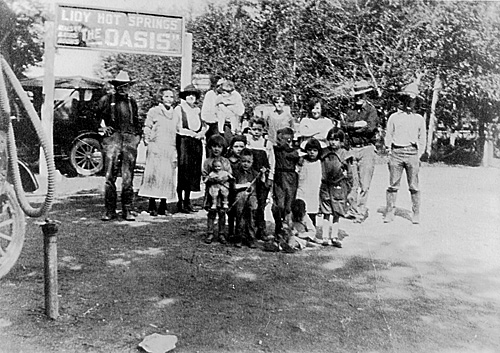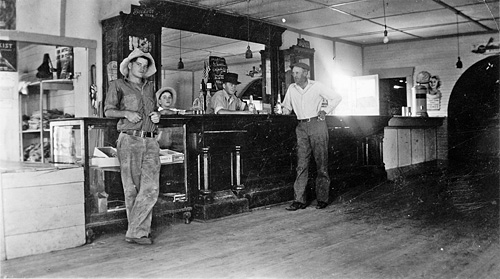Bob Lidy Develops a Major Resort
“The Thomas-Ellis connection.”
The most popular resort in Clark County for picnics, swimming and dancing was Lidy Hot Springs. Dances at Lidy’s brought the Thomas family from Medicine Lodge and the Ellis family from Crooked Creek together in the 1930s. Jean Ellis noted in her diary on May 5, 1935, “I became acquainted with the Thomas boys. They sure are nice and full of fun. We went swimming.” In my diary, I noted a few times that I danced with Jean Ellis. For example, on July 4, 1939, “I took in the rodeo in Dubois and the dance at Lidys. Danced a lot with Gene Lingo and Jean Ellis.”
Robert “Bob” Seamon Lidy, Jean’s Grandfather, was born in Ohio in 1865/66. As a young man, he came to Camas, Idaho where he was a freight hauler. “Bob Lidy could handle a ten-horse team and a sixteen-horse short line team with dexterity. He made many freight trips between the old mining town of Gilmore and Dubois, Idaho.”
Bob Lidy met and married Mary Sullivan, a widow with six children, who owned the property where a natural hot springs was located. Mary’s husband Michael Sullivan had obtained the property by trading a team of horses for it. The family that had it originally wanted to sell because they thought the water was making them sick.
Sullivan developed Lidys, then called Sulfur Springs, into a major freight and stage stop on the Dubois/Gilmore line. At that time Gilmore was a booming silver and lead mining center. The ten- and six-horse ore-hauling freight trains would roll into Sulfur Springs, where livery and feed was available for the animals, and meals and boarding for the teamsters.

Lidy Hot Springs, 1904. At this time Lidys was an important freight and stage stop, providing rooms and meals. Robert Lidy is sixth from the left and Mary Lidy third from the right, behind the corral post. The child in the center in front of the windows is Gertrude Lidy, Jean Ellis’ mother. Robert Lidy and Mary Neville Sullivan married in 1897.
When Lidy took over, he built the first bath, near the springs, which came out of the ground about a mile from the stage stop. Later he piped the hot water down to a big tub in the yard. Visitors paid 25 cents for a towel and bar of soap.

Robert and Mary Lidy with children and grandchildren. Sign says 'Lidy Hot Springs, The Oasis. Meals, Baths, Rooms.' 1926.
Business prospered and Lidy built a large, two story house for his family. A few years later, as Gertrude Lidy explained, the house burned down:
“My sister Margaret was going to iron and she had filled the stove with chips. The fire flared out, catching the wallpaper afire. The house burst into flames and burned in a moment, it seemed. We saved only a rocking chair and the sewing machine. No clothes, nothing was left, not even a bed. We cleaned out the shop area and were grateful to move into it.”
On March 1, 1917, Lidy leased Lidys and its lands to C. D. Beale and Company. Beale planned to erect a hotel and develop Lidys into a major resort and farming enterprise. On March 8, he published the following notice in the Idaho Falls newspaper:
“Other ground is being secured and management propose to turn the ranch and any additional ground that may be secured into a large diversified farm. Farm buildings will be provided along with a large green house and all kinds of farming and truck gardening will be carried on both in an experimental and permanent way…. The new hotel will be equipped along modern lines, catering to the general public and taking care of those who seek rest, recreation and medicinal baths.”
Beale’s timing was awful, because the mining at Gilmore was just then giving out. He built private hot baths, a large cement pool, a few buildings — and then went bust.

Lidy Hot Springs public swimming pool -- photo taken in 1924 before pool was covered. The doors lead to private hot baths. The cement pool and baths were built by C. D. Beale.
Lidy took back the property and added a dance hall, which became more popular than the baths. Families from the surrounding area went to many community dances at the resort.
An Overloaded Lumber Wagon
My uncle, Ollie Johnson told me this story about Bob Lidy. Mr. Lidy had decided to build a slatted wooden roof over the swimming pool at the Hot Springs. Since the nearest source of lumber was the Johnson sawmill on Middle Creek, Lidy decided to purchase the lumber from the Johnsons. He drove his four-horse team and lumber wagon up to the mill, about 10 miles away. Ollie said he ordered boards that were narrow at one end to fit the shape of the roof. “That worked fine for us,” Ollie said, “since we could take advantage of the natural shape of the tree.”
Johnsons cut the lumber and Mr. Lidy started loading the wagon.
“He just kept piling on boards until he had the entire stack we had cut. I told him that the load was too heavy for that wagon but he said he did not want to make an extra trip. Well, he got about 100 yards and one wagon wheel broke. We had to unload the lumber and pull the wheel. Then Mr. Lidy went to Dubois after a new wheel. He lost a couple of days and had to make two trips with the lumber.”
Dan and Mary Lease Lidy Hot Springs
“The big drought was continuing.”
After Mr. Lidy died the surviving family rented the resort to various operators. With Mother’s encouragement, our family leased Lidy Hot Springs in 1934. The Depression was in full swing and we needed the additional income. The big drought was continuing and Dad said, “When we moved to Lidys there wasn’t a spear of green grass. We had one milk cow and she nearly starved.” Dad eventually moved most of our cattle from Medicine Lodge and Deep Creek to Lidys and we utilized the hot water to raise as much hay as possible.

Daniel, Walter, Mom and Dad. About 1936. Lidys swimming pool in the background. Mary and Dan managed Lidys from 1934 to 1946.
One year we cut and stacked tumbleweeds (Russian thistle) for supplemental feed. The dust from the tumbleweeds really irritated our eyes and skin. However, when the tumbleweeds were young and green the cattle selected the plants. We could always tell when the cattle were grazing tumbleweeds. They were a good physic for milk cows and that presented a challenge when milking to try to avoid the swishing tail. We always had a few cows that kicked over the milk bucket. Dad always said “If a cow fresh off the pasture kicks her foot in the milk bucket we can call that ‘pasteurized milk.’”

Walter and Byron tending bar at Lidy Hot Springs. Daniel (left) and an unidentified customer. Lidy Hot Springs, 1936.
The move to Lidys was really exciting for the Thomas boys We met new and interesting people — some old and many our age — at the dances and in the swimming pool. We became good swimmers and my brother Byron followed up by making a letter in swimming at the University of Idaho.
One evening while we were refilling the pool after cleaning, Daniel, Byron and I decided to go swimming. Byron and I were first out of the dressing room and onto the diving board. Since the pool was only partially full we dived off one side of the board into the deeper water. Then Daniel followed us onto the diving board. Evidently he had forgotten the pool was only partially full because he jumped high, formed a jack-knife and landed in about three feet of water. His head hit the concrete bottom. As he came up he shouted “help” and sank back down.
Byron and I pulled him up the slope and out of the water. We left him there until we had completed our swim. Then we helped him down to the house. Mother tucked him in bed and he stayed in bed for six weeks. Byron and I thought he was just trying to get out of the farm work but when Mother and Dad finally took him to a doctor in Idaho Falls, the doctor said he had a broken neck and a cracked skull and “It was a good thing you did not try to move him earlier.”
Rodeos were another big event at the Hot Springs resort. We usually lined up local stock and had local participation in bucking, roping, wild cow milking, etc. At one of these rodeos, Pauline, one of our cousins, teased Daniel into getting on a bareback bucker. I had already taken a turn and been promptly thrown off. Daniel knew the doctor told him not to ride a bucking horse or get a blow to the head because of his broken neck. However, the peer pressure was so great that he climbed the chute and hopped on a bareback bronco. After about three jumps he hit the ground hard. I helped him up. He was barely conscious and he couldn’t even remember what happened. Anyway, he survived, but that was the end of his rodeo career.
Mother and Dad worked hard to promote Lidy Hot Springs as a regional resort. The first few years were tough, but the crowds gradually increased. Mother kept a record of the income and expenses for Lidys each year. The rental cost per month was $100 paid to Frank Sullivan, who represented the Lidy heirs. The net profit from swimming dances and confections for 1935 was $174.07. Records of three dances are shown below:
August 17, 1935 — net profit — $54.65
Paid Out:
Music $25.00
Wax for dance floor $1.50
Bread $2.00
Meat & Coffee $1.50
Ice cream $2.85
Received:
Tickets $37.50
Supper $10.00
Baths $10.00
Fountain $30.00
August 24, 1935 — net profit $24.80
August 31, 1935 — net profit $24.98
We supplemented the income from the Hot Springs by renting the Davis Place on Medicine Lodge Creek, selling horses and other livestock from the ranch and in most years Dad contracted to cut and stack hay for Frank Reno on Birch Creek.
We operated Lidy Hot Springs on and off until 1946. The war years took a toll on income for the folks. In addition, Byron and I left for the Navy and Daniel went to Alaska with his new bride, Betty Rider. Nevertheless, experiences at Lidys provided interactions for “us kids” far beyond the routine of farm and ranch chores.
Mormon Crickets
“We gotta do something.”
During the 30s, what we called Mormon Crickets (Anabrus simplex) were a reoccurring problem. One day when I was riding for cattle, I spotted a huge cloud of crickets that appeared to be heading for Lidys. The infestation must have contained millions of crickets and was about a mile wide and a mile deep.
I rushed home and told Dad. He said, “We gotta do something to keep them out of the pool. There’s nothing we can do about the fields.” We strung old cans on wires and got out brooms and rakes and watched the crickets head straight for the place. Every once in a while the crickets would change their noise and all stop. Then they ate everything down to bare dirt. Suddenly, with a noise change, they would move forward again. When they began to reach Lidys, we shook the cans, trying to split them around the buildings. At first the noise caused them to jump away from the sound. But as they got thicker and thicker, they just forced themselves forward. We finally gave up.
They covered everything. They climbed up the sides of the buildings into the eaves, they went through the shop and ate the leather, and they plunged into the swimming pool. A rattle snake we had killed shortly before they arrived, we later found eaten down to the bones. They ate even their dead.
In the pool at first they drowned, but eventually they formed a bridge of dead and live bodies and just marched across the water.
The largest crickets were about 3 inches long.
When they were gone, they left behind millions of dead. We worked like the dickens to clean them up, raking them into huge piles. We drained the swimming pool and had a terrible time cleaning it. The next day, the stink was terrible.
The county responded to the infestations by spraying, and killed several of our cows with their poisoning. Mother wrote numerous times asking the county for compensation, but was refused.
When a wave of crickets crossed a road, they’d get smashed by passing cars, creating a dangerous slick.
By the end of the decade, they were no longer a serious problem. The spraying programs were very successful in killing them before they grew into unstoppable bands.
Jack Rabbits
Jack Rabbits were another scourge. They could devastate a field of alfalfa in no time. They’d eat so much hay around the base of a hay stack that it’d fall over.
To try to keep them down, we’d go out at dusk with a 22 rifle and boxes of shells. As they crept into the field from the open range, we’d shoot them.
Ranchers in the area began to organize rabbit drives. Riding horses, they drove thousands of rabbits into a confined area. Then they would dismount and club them to death. Many people objected to killing them that way, however.
Some people would skin or even eat Jack Rabbits, but we never did, because Mother was scared we’d get rabbit fever (tularemia).
Clark County Loses a Treasured Resort
In addition to the Thomas family, several other families operated Lidy Hot Springs. These included Mr. and Mrs. Claude Bare and Jean’s brother Robert. Dennis Sullivan was operating Lidys when he passed away in 1955. Soon after Den’s death the Hot Springs was sold to Mr. and Mrs. Ed Wilson of Dubois.
As stated in the clipping from the Salt Lake Tribune dated June 20, 1962, Ed Wilson had big plans for the resort, including adding a golf course and a motel. These plans soon evaporated and the Wilsons turned their attention to their expanding mining operations. They covered over the swimming pool, tore down the dance hall, and removed other resort buildings. The Wilsons have utilized the water for power and constructed extensive processing facilities to supplement their mining interests.
Old timers in the region now mourn the loss of one of Clark County’s best recreational centers. Fond memories remain of swimming in natural hot water, dancing to the tune of local bands, and socializing at a great recreational resort established by Jean’s grandfather, at Lidy Hot Springs.
Lidy’s Cemetery
In the field below Lidys is a cemetery, now completely unmarked. I believe the first burial was Arthur Lidy, the second child of Robert and Mary Lidy, who died at 2 years of age in 1901. Two other infants are buried there, a Thomas (no relation) buried in 1918 who was the child of a dry farmer and an Eastman child, whose father was a Gilmore freighter.
In the winter of 1905, John Moran was buried in the cemetery. He was a Congressional Medal of Honor winner. His citation is for “Gallantry in Action” at Seneca Mountain, Arizona on August 25, 1869 in a battle with Indians. Moran was a private in Company F, 8th US Cavalry. The citation was awarded March 3, 1870. Moran was born in Ireland, date unknown. Pettite reports that Moran lived a mile above what is now known as Lone Pine Lodge and died during the winter of 1905.
In 1907, Andrew Jackson Myers was buried in the cemetery. Myers was a good friend of Robert Lidy and had known Mary Lidy’s first husband well. He had homesteaded on Myers Creek, which is named after him.
Note: See here for an update on the Lidy Hot Springs Cemetery.
End of the “Free Range” in the West
“The horses were trailed to the cannery in Butte, Montana.”
The year 1934 brought another major change to the ranching industry. This was the year the Taylor Grazing Act was passed by Congress and signed by President Franklin Roosevelt. This meant the end of the “Free Range” in the West and the beginning of regulated grazing allotments to reduce widespread “overgrazing.”
Members of the Thomas family had several ranch holdings in Clark County, Idaho. My Dad ran cattle and over 100 head of horses. Two uncles were sheep ranchers, and the old home ranch was now run by Uncle Rees, who had large numbers of cattle and horses. All of the Thomas brothers were independent — and bashful. Rees refused to go to the Taylor Grazing office to sign up and claim his long-term rights to open range. Several others were not aggressive enough to compete with the more recent and better educated newcomers in the area, or they refused to cooperate with the new bureaucrats in the Department of Interior. As a result, the Thomas brothers all came up short on Taylor Grazing Rights and Rees was left with only a small piece of property on Lower Medicine Lodge. He later found that he could not graze on “his” traditional range, and since he had livestock with no place to go, he was forced to liquidate when prices were at the lowest point in years. Rees soon went broke and lost the home place.
One of the saddest days I remember on the ranch was when my brothers and I sat on the corral fence with my Dad and Mother, looking at several hundred head of surplus or “trespass” horses. These horses were rounded up by local ranchers, trailed to the cannery in Butte, Montana, and sold for $10 a head — mare with colt at the same price. We held back several good potential saddle horses, but from that day on, we were essentially out of the horse business. Mother said, “We had to sell back to 25 head.”
— A Winding Road to the Land of Enchantment
Buy Amazon Ebook copy of The Winding Road to the Land of Enchantment here ($2.99)

















